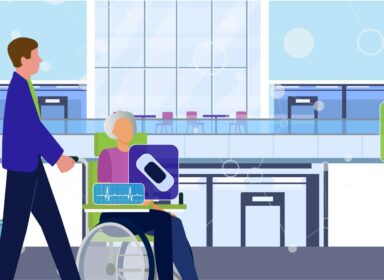The Central Role of Telemetry in Shaping a Stronger Future for Healthcare
The ultimate aim of healthcare is singular and uncontested: make patients well. But the ability to orchestrate better patient outcomes is multi-faceted, made possible by a healthcare ecosystem that is more experience-focused, more financially viable, and more focused on the people receiving and delivering care. To support the advancement of this mission, the Institute of Healthcare Improvement (IHI) first introduced the “Triple Aim” in 2007.
In 2014, and again during the pandemic in 2021, the three aims were expanded upon to include two additional objectives that are equally instrumental to the delivery of better care, and the pursuit of better outcomes. These aims are not only beneficial for the patient, but they also hold the potential to impact the economy in an undeniable way. According to a 2021 report from the McKinsey Global Institute, prioritizing health care using the aims could help build $12 trillion in economic opportunity by 2040.
At InfoBionic, we’ve written extensively about the central role of virtual telemetry in enabling virtual healthcare models and achieving the industry’s ambitious goals for quality, cost-effectiveness, access, and outcomes. In this blog post, we’ll support this assertion in a compelling way by examining virtual telemetry’s unique ability to advance each of the five healthcare aims.
From Three Aims to Five
Before we dive in, let’s consider the IHI’s reasoning for expanding its aims from three to five between the years 2014 and 2021.
The IHI introduced the “Triple Aim” concept to improve health and patient experience while simultaneously decreasing the costs of care. Providers believed that delivering a better experience would result in improved patient outcomes, and reducing costs would enhance accessibility and make a positive impact on both outcomes and experience over time.
Healthcare leaders recognized the need to add a fourth aim addressing the pervasive burnout in the healthcare workforce—even before COVID-19. With 62% of nurses reportedly experiencing burnout, the outsized demands placed on frontline workers were unprecedented and shed light on the undeniable relationship between healthcare outcomes and clinician well-being. The “Quadruple Aim” addressing employee burnout was thus announced in 2014.
More recently, the Aims were expanded upon once again, this time to address health inequity, which is a key obstacle to improving outcomes universally. COVID-19 truly shined a light on the lack of health equity in the US and beyond. According to the Commonwealth Fund, profound racial and ethnic inequities in healthcare exist across the US—there are large disparities in the access to care between white and most nonwhite populations, and a lack of insurance is one factor that contributes to premature, yet preventable, deaths for people of color. Thus, the “Quintuple Aim” of Healthcare was developed as a result of these pervasive issues.
Let’s explore the Aims in closer detail, and uncover what they have accomplished.
Aim 1: Improve Patient Experience
Healthcare experts say that consumers’ expectations for healthcare services are rising, just as they are in virtually every other industry. This means that enhanced patient experience is not only vital to adherence, but it is also vital to attracting and retaining healthcare consumers. Virtual telemetry reduces inconvenient and cumbersome testing procedures by enabling sophisticated, hospital-grade monitoring from nearly anywhere. Empowered with convenient virtual telemetry solutions that are easy to operate, patients can become active and enthusiastic participants in their care.
Aim 2: Better Outcomes
Fostering better healthcare outcomes at scale requires healthcare to intervene more proactively and embrace every opportunity for preventative care. Virtual telemetry enables more proactive and precise interventions by providing vital monitoring data about a patient that might have historically been low quality, or worse, absent altogether. For patients with high-risk factors, virtual telemetry can serve as a regular and repeatable aspect of ongoing care. Equipped with high-fidelity data at all times, not just in the wake of an emergency event, providers can focus on more effective prevention and management—two essential aspects of better healthcare outcomes.
Aim 3: Lower Costs
One often-overlooked aspect of virtual telemetry is its ability to monitor with equal acuity and far lower costs than traditional, in-person monitoring. In fact, appropriate utilization of telemetry alone helped leaders at Christiana Care Health System reduce costs by $4.8 million in a year and avoid $100 million in costs during a five-year period. Through virtual telemetry solutions like the MoMe™ ARC Platform, patients can be discharged without eliminating provider visibility, effectively reducing the length of hospital stays and their associated costs.
Aim 4: Clinician Well-Being
Overburdened clinicians have always been a concern in healthcare—as evidenced by the introduction of this aim in 2014—but this concern was even more radically intensified by the COVID-19 pandemic of 2020. The burnout is clearly here to stay. A study in Mayo Clinic Proceedings showed more than 3 in 5 physicians reported at least one instance of burnout. Many factors can lead to clinician burnout, such as regulatory requirements, administrative responsibilities, and the clinical practice environment. Virtual telemetry reduces the onus on physicians by providing continuous data and AI-assisted analytics in one, unified interface that is accessible from anywhere.
Aim 5: Health Equity
Despite the universal importance of healthcare, high-quality patient care remains just out of reach for many Americans. The healthcare divide is intensified by geography, socioeconomic status, and race. In fact, out of the 30 million uninsured Americans, about half are people of color. Virtual telemetry is a powerful tool in improving health inequity because of its incredible ability to make high-quality monitoring accessible for patients anywhere—even in areas that are not in proximity to the best providers. While it is true that the digital divide can intersect with the healthcare divide, posing a challenge to web-based virtual telemetry, widespread efforts to improve internet access continue to lower the barriers to adoption.
Working with InfoBionic to Achieve the Quintuple Aim
InfoBionic believes virtual telemetry firmly advances all five of the Quintuple Aims, and its continued utilization is core to embracing healthcare’s new virtual care reality. Finding a virtual telemetry platform marked by innovation and quality is among the most important decisions a modern-day hospital can make. At InfoBionic, we recognize the importance of virtual telemetry in achieving the Quintuple Aim, and the MoMe™ ARC Platform provides the acuity and flexibility modern care providers need to meet a full range of virtual cardiac monitoring use cases.
If you’d like to learn more about the MoMe™ ARC Platform and how it can improve experiences, outcomes, cost effectiveness, clinician satisfaction, and health equity in your organization, contact a member of our team today.


